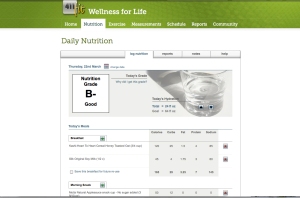Weight Loss Unmasked: A five part series looking deeper at why we struggle with losing weight
By Briana Boehmer
I’m amazed at how little we pay attention to the content of the food we eat. As I walked through the grocery story this evening I took a moment to grab items I NEVER entertain buying. I wanted to remind myself of WHY I don’t buy them. First ingredient SUGAR…okay, don’t need that. Yellow lake 5…mmmm, what food group is that? Hydrogenated…what? If you read a label and you have to think about what you are reading, put the item BACK!
My point is simple – what VALUE does the food you are eating have to your body? What will it DO FOR YOU? Just like when you got to a financial advisor to help you build your portfolio, go to food to help build a strong, healthy body. Just liking saving money for retirement, what you eat now has a huge impact on quality of life down the road.
 I know the question you are now asking…”What do I eat then?!” I do believe that is a very personal question sometimes, however there are GREAT tools you can use to help guide your food choices. I was fortunate to listen to a brilliant man by the name of Dr. David Katz speak last year at a state wellness conference. He is the brains behind an innovative nutrition labeling system called NuVal. The system is VERY SIMPLE. The NuVal System scores food on a scale of 1-100. The higher the NuVal Score, the better the nutrition. Check it out here: http://www.nuval.com/
I know the question you are now asking…”What do I eat then?!” I do believe that is a very personal question sometimes, however there are GREAT tools you can use to help guide your food choices. I was fortunate to listen to a brilliant man by the name of Dr. David Katz speak last year at a state wellness conference. He is the brains behind an innovative nutrition labeling system called NuVal. The system is VERY SIMPLE. The NuVal System scores food on a scale of 1-100. The higher the NuVal Score, the better the nutrition. Check it out here: http://www.nuval.com/
What I LOVE about NuVal is that it takes into account the true nutritional value of the food you eat. Medical and nutrition experts lead by Dr. Katz and the Yale Prevention Research Center spent two years to develop the Overall Nutritional Quality Index (ONQI™), a complex and advanced algorithm which converts complex nutritional information into a single, easy-to-use score – The NuVal Score. The score goes beyond the basic nutrition label to really determine what value the food has. It considers 30-plus nutrients and nutrition factors – the good (protein, calcium, vitamins) and the not-so-good (sugar, sodium, cholesterol). In a nutshell it weighs the good with the bad to produce a number you can trust to make better decisions about nutrition in just a few seconds.
First things first, I’m not saying you need to memorize the NuVal score for every food you eat. What I am saying is that you should take the time to understand what the foods you eat are providing your body. For example, a cereal I have always loved, Kashi Strawberry Fields, has a NuVal score of 10! Compare that to blueberries…they have a score of 100! For examples of NuVal scores follow this link: http://www.nuval.com/scores
The biggest drawback right now with NuVal is that you can only find them posted in certain grocery stores across the nation. Check out if a store near you displays them: http://www.nuval.com/location. If you do not have a store near you that supports NuVal, suggest that your local market start to! Also take time to search through the NuVal website. There are some great educational resources to take advantage of – Like suggestions on how to replace foods you eat with better choices (they call “trading up”) and an interactive “nutrition by the numbers” game where you can test your knowledge on the foods you eat!
Understanding what you are putting in your body is one of the fundamental components of successful behavior change and weight loss. NuVal is one tool I feel has significant merit. Knowledge truly is power…when you know what you are buying you are more apt to think twice.
Read the other blogs in this weight loss series:

